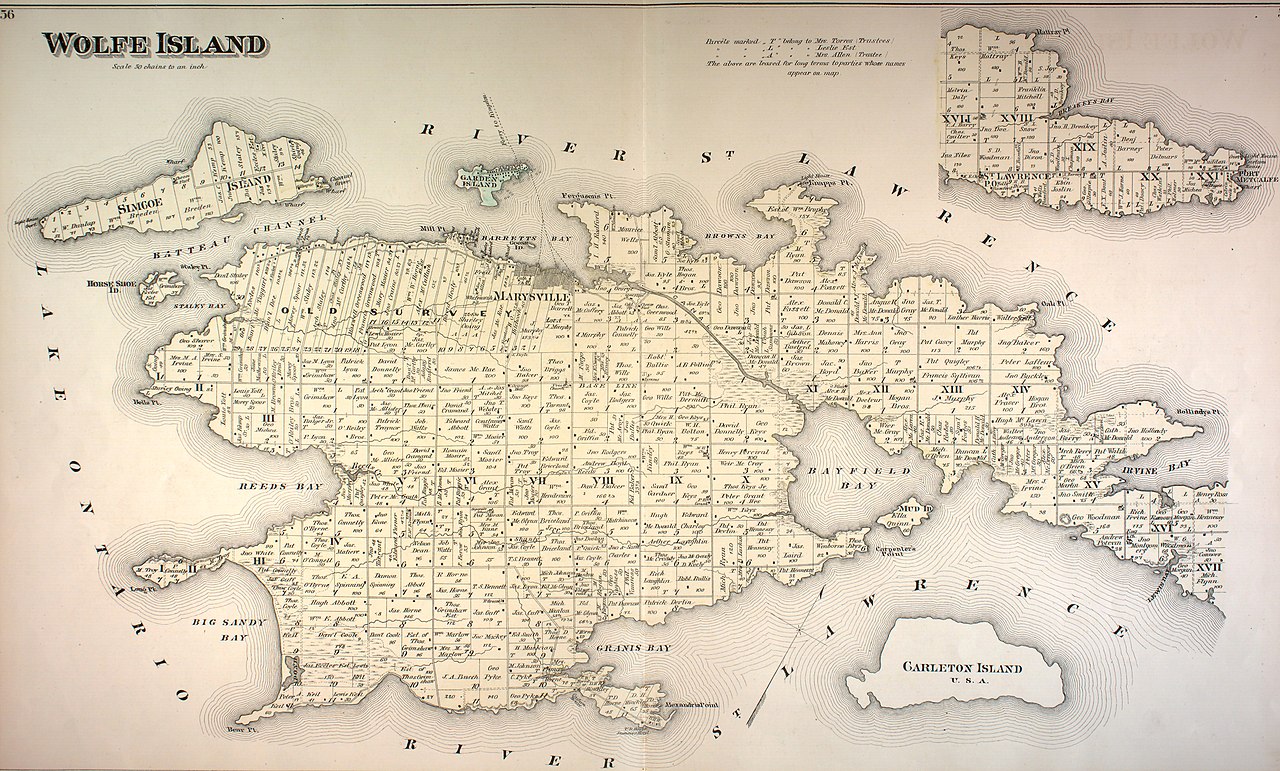The Wolfe Island Canal

The Wolfe Island Canal, from Barrett Bay to Bayfield Bay, opened in 1857; it was about two miles (3.5 km) long, dredged from a natural depression as topologically and geologically Wolfe Island should be considered as two islands in very close proximity. It was an expensive, underfunded project with limited use. Merchant steamers (let alone sailing vessels) had to be built with very shoal draft to get through, so it was mostly used by passenger ferries and excursion-type vessels – and if one was going one way and met bow-on with another, one had to back down. It was never wide enough for two vessels to pass. Remnants still exist but more than half of it is now dry land (maybe puddles up in rain storms.) There's a road "bridge" at the northern end with no water underneath it.
It was established under pre-confederation Canadian jurisdiction, 14 & 15 Victoria, Chapter 149 on 30 August 1851, 'An Act to incorporate the Wolfe Island Rail-way and Canal Company' naming the original owners as Francis M. Hill, John Macpherson, Thomas Kirkpatrick, William Ford the younger, John K. Forsyth, Henry Smith the younger, John Watkins, Ellery W. Palmer, Noble Palmer, George Baxter, Henry Gildersleeve, John A. Macdonald, Colin Miller, Maxwell W. Strange, John Counter and Alexander Campbell, capitalized at fifty thousand pounds sterling. This after a previous 'Wolfe Island, Kingston and Toronto Rail-road Company' announcing capitalization of one million pounds [1] had gone nowhere.
After reducing the capital requirements by 95%, it must be concluded that this was an opportunistic investment with no long-term future. The fact that a local US Cape Vincent newspaper lamented its demise seventy years later is interesting – but not persuasive enough for any investor to raise major funds for very limited, probably zero, returns on capital.
The following is adapted from Canals of Canada by Robert Legget
At the other end of Lake Ontario, there may still be seen the remains of yet another comparatively unknown canal venture, this one actuated rather than defeated by the advent of the railways. The key location of Kingston at the eastern end of Lake Ontario was naturally mentioned in connection with the southern end of the Rideau Canal. Facing Kingston in the broad waters of the River St Lawrence as it leaves the lake is Wolfe Island, a narrow island about 14 miles long, separating the river into two main sections about three miles and one mile wide respectively. Some sort of ferry service had operated from the earliest days of settlement between Kingston and Wolfe Island and then from the south side of Wolfe Island to Cape Vincent on the American shore. The importance of this service was increased in the 1830s when Kingston was made the official customs ‘Port of Entry’ from and ‘Port of Exit’ to Cape Vincent for all the Canadian settlements between Cornwall and Port Hope (about 200 miles). The ferry became even more important when the railway reached Cape Vincent. Interested citizens conceived the idea of excavating a canal across Wolfe Island, in order to avoid the nuisance of transshipment. They had a survey made, the route being 24 miles long, naturally with no locks, and prepared a petition that was addressed to the Governor, Sir John Colborne, on 25 February 1834. He commended it to the Legislature but, probably because this was near the time of the troubles (1837), nothing was done.
In 1846 the matter was revived and an Act passed incorporating the Wolfe Island, Kingston and Toronto Railway Company. Its name indicates the hopes behind it but the Act lapsed. Another Act was passed, however, incorporating the Wolfe Island Railway and Canal Company and this company did build the Wolfe Island Canal; it was finished in 1857. To begin with it had a depth of 6 ft, later increased to 7 ft. It was in regular use for the Kingston to Cape Vincent Ferry service for over 20 years but the service was given up before the end of the century and the canal allowed to fill up with weeds. There have been several suggestions, down the years, that it should be cleaned out and dredged again but nothing has been done and so the old canal remains as a strange weed-filled depression across this lovely island, not often even recognized for what it was. The company that constructed it originally has a special interest for Canadians since the great Canadian prime minister, Sir John A. Macdonald, when a young lawyer in Kingston, was associated with this canal venture.
